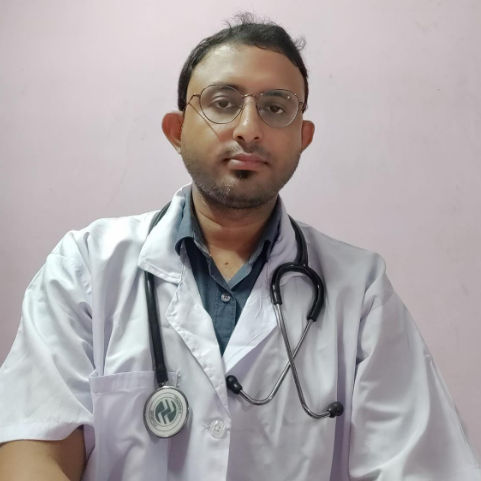Back acne, typically known as "bacne," is a prevalent skin condition that can be physically uncomfortable and emotionally distressing. While facial acne often receives more attention and treatment options, back acne is usually ignored despite affecting a substantial portion of the population, specifically during the teenage years and early adulthood. Characterised by pimples, blackheads, whiteheads and, in severe cases, cysts and nodules on the back, this condition can profoundly impact an individual's quality of life.
The skin on the back is thicker and contains a higher density of sebaceous (oil) glands than other body parts, making it more prone to acne breakouts. Addressing and managing back acne effectively is essential for maintaining healthy skin and boosting self-confidence and overall well-being.
What Causes Back Acne?
Back acne develops when hair follicles on the back become clogged with excess oil (sebum), dead skin cells, and bacteria. Several factors can contribute to the development of back acne, including:
Hormonal Changes: Fluctuations in hormones, particularly during puberty, menstrual cycles, and pregnancy, can increase sebum production and trigger acne. Androgens, a group of hormones that includes testosterone, can stimulate the sebaceous glands to produce more oil, leading to clogged pores.
Genetics: A family history of acne can predispose individuals to develop back acne. If your parents or siblings experienced acne, you might also be more likely to suffer from it due to inherited traits that affect oil production and skin cell turnover.
Sweating: Excessive sweating can exacerbate acne, especially during physical activities or in hot and humid environments. Sweat can mix with oils and dead skin cells, clogging pores and increasing bacterial growth.
Friction: Tight clothing, backpacks, and sports equipment can cause friction and irritation, leading to acne breakouts called "acne mechanica." Acne mechanica occurs when physical pressure or rubbing disrupts the skin barrier and blocks pores.
Poor Hygiene: Infrequent washing of the back or failure to remove sweat and oil can contribute to clogged pores. Regular cleansing helps remove excess oils and dead skin cells that can lead to acne.
Diet: Certain dietary choices, such as high-glycemic foods (e.g., sugary snacks, white bread) and dairy products, may influence acne development. These foods can cause spikes in blood sugar and insulin levels, which in turn cause increased oil production and inflammation.
Types of Back Acne
Back acne can manifest in various forms, each requiring a different approach to treatment. Understanding the types of acne lesions can help in choosing the most effective treatments:
Whiteheads: Small, closed comedones that form when pores are clogged with sebum and dead skin cells. They appear as tiny, white bumps on the skin's surface and are often less inflamed than other types of acne.
Blackheads: Open comedones that appear black due to oxidation of the trapped sebum. Unlike whiteheads, the pore remains open, allowing the trapped oil to react with oxygen and turn black.
Papules: Small, red, inflamed bumps that can be tender to the touch. These lesions do not contain pus and are often the result of an inflammatory response to clogged pores.
Pustules: Red, inflamed bumps with a white or yellow pus-filled centre. Pustules are similar to papules but contain pus, making them more likely to cause scarring if picked or squeezed.
Nodules and Cysts: Deep, painful, and larger lesions that can lead to scarring if not treated properly. Nodules are hard, inflamed lumps that develop deep within the skin, while cysts are softer, pus-filled lesions.
Effective Treatment Options
Managing back acne requires a combination of topical treatments, lifestyle modifications, and, in some cases, medical interventions.
Here are some effective treatment options:
1. Topical Treatments
Benzoyl Peroxide: Over-the-counter (OTC) benzoyl peroxide gels and washes can help reduce bacteria and inflammation. It works by killing the bacteria that cause acne and reducing excess oil production.
Salicylic Acid: Salicylic acid cleansers and creams can exfoliate the skin and unclog pores. This beta-hydroxy acid penetrates deep into the pores, helping to remove dead skin cells and reduce inflammation.
Retinoids: Topical retinoids, such as adapalene, can promote cell turnover and prevent clogged pores. These vitamin A derivatives help normalise skin cell shedding, reducing the formation of comedones.
Alpha Hydroxy Acids (AHAs): AHAs like glycolic acid can help exfoliate the skin and improve texture. These acids dissolve the bonds between dead skin cells, allowing them to be shed more easily.
2. Prescription Medications
Topical Antibiotics: Clindamycin and erythromycin can reduce bacteria and inflammation. They help to control the growth of acne-causing bacteria and reduce redness and swelling.
Oral Antibiotics: Oral antibiotics like doxycycline and minocycline may be prescribed for moderate to severe cases. These medications help to decrease inflammation and bacterial growth throughout the body.
Hormonal Therapies: Birth control pills and anti-androgen medications can help regulate hormones in females. These therapies can be particularly effective for women whose acne is linked to hormonal fluctuations.
Isotretinoin: A potent oral retinoid for severe, treatment-resistant acne, typically used under dermatologist supervision. Isotretinoin reduces the size and activity of sebaceous glands, leading to a significant reduction in oil production.
3. Procedural Treatments
Chemical Peels: Chemical peels use acids to exfoliate the skin and improve acne. They can help to remove dead skin cells and reduce the appearance of acne scars.
Laser Therapy: Laser treatments can reduce acne by targeting bacteria and reducing inflammation. Laser therapy can also help to improve skin texture and reduce scarring.
Light Therapy: Light therapy, including blue light and red light treatments, can help reduce acne by targeting bacteria and inflammation. These treatments are often used in combination with other acne therapies.
Lifestyle Modifications
Hygiene Practices: Regularly shower after sweating, use gentle cleansers, and avoid scrubbing the back harshly. Proper cleansing can help remove excess oils, sweat, and debris contributing to acne.
Clothing Choices: Opt for loose-fitting, breathable clothing to reduce friction and irritation. Natural fabrics like cotton allow the skin to breathe and can help prevent sweat buildup.
Dietary Adjustments: Incorporate a balanced diet rich in fruits, vegetables, and whole grains while minimising high-glycemic foods and dairy. A diet that supports overall health can also benefit your skin.
Stress Management: Practice stress-reducing techniques such as yoga, meditation, and regular exercise. Stress can trigger hormonal changes that may exacerbate acne, so managing stress is an essential aspect of treatment.
Preventive Measures
Preventing back acne involves maintaining good skin hygiene and adopting a few key practices:
Daily Cleansing: Wash your back daily with a gentle, non-comedogenic cleanser, especially after sweating. Cleansing helps remove excess oils and debris that can clog pores.
Exfoliation: To remove dead skin cells, exfoliate your back once or twice a week with a mild scrub or chemical exfoliant. Exfoliation helps prevent clogged pores and can improve skin texture.
Hydration: Keep your skin moisturised with a non-comedogenic, oil-free moisturiser. Hydrated skin is less likely to produce excess oil, which can contribute to acne.
Sun Protection: Apply sunscreen to your back when exposed to the sun, as UV rays can worsen acne. Look for non-comedogenic sunscreens that won't clog pores.
Avoid Picking or Squeezing: Refrain from picking or squeezing acne lesions to prevent scarring and infection. Picking can introduce bacteria into the skin and lead to more inflammation and potential scarring.
Conclusion
Back acne can be a persistent and aggravating condition, but with the right approach, it is manageable. Understanding the causes, implementing effective treatments, and adopting prophylactic measures can help you achieve clearer, healthier skin. Consistency in your skincare routine is important, and seeking professional guidance from a dermatologist can provide additional support in your acne management journey. By staying informed and proactive, you can take control of your skin health and significantly reduce the impact of back acne on your life. Remember, the journey to clear skin is a marathon, not a sprint—patience and perseverance are key.
Consult Top Dermatologist

Dr. Hemalatha Naidu M
Dermatologist
5 Years • MBBS, MD (Dermatology)
Bangalore
Apollo 24|7 Virtual Clinic - Karnataka, Bangalore
(150+ Patients)

Dr. K Chetana
Dermatologist
13 Years • MBBS, MD ( Dermatology)
Hyderabad
Apollo 24|7 Virtual Clinic - Telangana, Hyderabad
(25+ Patients)

Dr Ritika Shanmugam
Dermatologist
6 Years • MBBS, MD (Dermatology, venereology, Leprosy)
Bangalore
Apollo 24|7 Virtual Clinic - Karnataka, Bangalore

Dr. Madhab Datta
Dermatologist
5 Years • MBBS, MD (DVL)
Kolkata
Dr. Madhab Datta's Clinic, Kolkata

Dr Maloy Pramanik
Dermatologist
13 Years • MBBS,MD (DERMATOLOGY, VENEREOLOGY, LEPROSY)
Kolkata
S & S Polyclinic, Kolkata
(25+ Patients)
